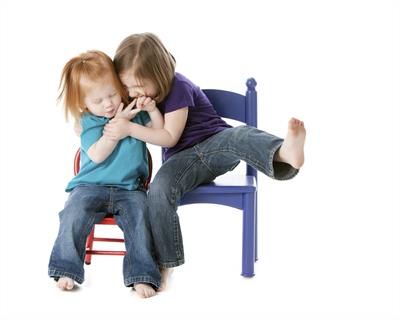
You can't prevent all sibling fights. In fact, you wouldn't want to. Conflict is a part of every human relationship, and kids learn from fighting with each other how to express their needs and wants, respectfully set boundaries on the behavior or others, and problem-solve to find solutions that work for both people. But you can reduce fighting, and make the fighting that does occur more civil. Here's how.
1. Empathize with your kids' feelings about each other, but set definite limits on their actions.
Kids are entitled to their feelings, which have a way of showing up in human beings, like our arms and legs. But all humans, even little ones, should be held responsible for what they do with their arms and legs and feelings.
"When your brother messes with your things you get really angry. You can tell him how it makes you feel in words. No hitting."
"You wish you could stay up half an hour later, like your sister. I know you can't wait until you're in third grade, so you'll be able to stay up later too. In the meantime, you can tell me if you're jealous of your sister, but you can't mess up her room."
2. Brainstorm with your kids about how to resolve conflicts peacefully:
For instance:
- “Say what you need or want without attacking the other person."
- "Listen to what the other person says and repeat it to show you heard."
- “Stay respectful.”
- “Stay in the current issue, don’t bring up past conflicts.”
Post the list on the fridge and model referring to it.
3. Teach kids healthy self-calming techniques
...which can be a challenge. Most of us never learned to regulate our own emotions as kids, so these are skills we don't necessarily model so well. Sometime when they're calm, make a game out of working with your kids on a list of healthy ways to calm themselves when they're angry, so they can then have a civil discussion and work things out. For instance:
- "Play the drums."
- "Write in your journal about how angry you are."
- “Dig a hole in the back yard and bury your angries.”
- “Breathe and count backwards from 10.”
- “Get a grownup.”
- "Put on headphones and dance to loud music."
- "Kick the soccer ball outside."
Post that list on the fridge also, and refer to it when you’re mad, in front of them, to model using it.
4. Expressing emotion verbally is the first step in managing it.
As you go through daily life, notice your kids’ emotions and experiences and acknowledge them, non-judgmentally.
- “No wonder you're angry! It’s so frustrating when you work hard on something and it collapses like that.”
- “This day really isn't going the way you wanted, is it?”
- "It sounds like you really miss your friend.”
Don’t feel like you need to solve their problems or talk them out of their feelings, just acknowledge the feelings so they can, too.
5. Teach your kids that anger always has a message.
Maybe that message is that their sibling trespassed a boundary, either materially (breaking their toy) or emotionally (disrespecting them.) The anger is defending them from this trespass and from the underlying hurt, powerlessness, sadness, etc. Acknowledging the underlying feelings is always more effective to diffuse anger than simply labeling the anger, which just seems to reinforce it.
“I hear you’re very angry at Jimmy. It could really hurt to have him say that your idea was stupid.”
This is even more important when kids say "I hate her!" because hate is not a feeling; it's a stance--a position we take that says we refuse to connect and work things through.
"You feel so angry at your sister right now that you feel like you hate her and you never even want to work things out with her. Sometimes when we are very, very angry, we feel that way, even toward people we love. Let's go tell your sister how hurt you are that she punched you, and how angry that makes you feel."
6. Cultivate empathy in your kids.
Encourage your child's understanding of, and comfort with, other people's emotions by wondering aloud about other kids’ feelings:
- "Look at Michael. He's crying. I wonder if his feelings are hurt.”
- “That little girl is sure mad. I wonder why?"
- "Keisha hurt herself. I wonder if we can do anything to help her feel better?"
Most important, offer your kids empathy for their own feelings, which is the foundation of their developing empathy for each other.
7. Intervening in a sibling fight.
Sometimes children can work things out themselves, but often they can't, either because they don't yet have the skills or because they're simply too angry. So don't hesitate to intervene, as long as you can do it calmly and without choosing sides. That actually teaches children the conflict resolution skills they need, and research shows that it reduces fighting in the long run, and helps kids fight more constructively.
The mistake most parents make is that they think they have to decide who is right and what the resolution should be. But that just convinces the child who "loses" that you love the other child more. Instead, restate each child's perspective and wants, and express confidence that once everyone calms down, they can come to a resolution.
- Calm yourself.
- Create Safety.
- Uphold standards of civility: "No name calling....You can tell your sister how angry you are without calling names."
- Never take sides.
- Help kids express their feelings and needs to each other.
- Empathize and restate each child's point of view.
- Back your child up as necessary: "What did you hear your brother say?"
- Help kids repair, do over, or find win-win solutions.
8. Coach kids to problem-solve together, so they learn how.
- Model calm.
- If the conflict is over an object, move it away.
- Describe the problem without judgment.
- Invite the children to come up with solutions; write them down.
- Go through the solutions one at a time.
- Restate objections, compromises, and solutions as they’re offered.
- Get agreement on the solution.
9. Teach your kids basic negotiation and problem-solving skills
guided by the concept of win/win:
- Taking turns
- Dividing a treat (one person does the dividing, the other picks the first piece)
- Trading
- Sweetening the deal (“We play your game first and then my game for longer”)
10. Enforce standards of respect in your home:
"We don't call people names or tolerate meanness in this house. We treat each other with respect."
"No name calling. You can tell your brother how mad you are at him without calling names."
Set up an expectation that if anyone forgets themselves and calls a name or is disrespectful (this includes adults!), they need to “repair” the damage they've done to that relationship. (Do a favor, help rebuild the tower you knocked down, make a card.) This doesn't mean your kids can't disagree. It means that there is always a way to stay respectful, even if we're angry. Wouldn't it be a different world if everyone learned this in childhood?
11. Intervene before a fight erupts.
Many children can play together happily for only limited periods, and then they need a solitary activity for awhile. Others love constant engagement, and when they get bored, they get irritable, and start to pester their siblings. Notice these tendencies and intervene BEFORE they fight, to protect the sibling relationship, not to mention your sanity.
Keep tired and hungry kids away from each other and avoid situations that create fights. For instance, separate kids in the car as much as possible. If they do have to sit in adjacent seats, give them separate music devices, headphones and an incentive.
"It can be hard to sit in a car for so long, and when you get grumpy, it would be easy to take it out on the other people in the car. But let's see if we can do this in a happier way. Can you two be a team? You can work together to come up with ways to help everyone in the car feel happier!"
12. If you have a "hitter"
...talk with her privately about what is making her so angry at her sibling that she's hurting him. Having a chance to feel heard about her upset will diminish the force of her feelings so that she doesn't have to act on them.
Give your child help in learning to handle her anger appropriately. For instance, teach her that when she gets mad, she can yell a code word like "STOP!" and clap her arms around her body (so that her right hand is on her left shoulder or under her left arm, and vice versa). This works because it redirects the feeling of wanting to lash out to protect oneself into a self-hug that contains and protects.
Point out that she can call you if she needs your assistance in resolving a problem with her sibling, and tell her calmly but firmly that you expect her to control her emotions, use her words and NOT touch her sibling in anger.
13. Set a good anger-management example.
That means treating everyone, including your kids, respectfully. No swearing when someone cuts you off in traffic, no demeaning asides about your partner forgetting to fill the gas tank, no yelling at the kids. (Really. Yelling teaches them to yell--at each other.)
14. Model conflict resolution with your partner and other adults, as well as your kids.
Role model constructive conflict resolution. Contrary to popular myth, “fighting” with loud voices and angry words never works things out constructively; it just makes us more angry. Instead, take a “cool-off” period and then come back determined to stay calm, acknowledge the other person’s view, express your own needs, and work things out.
15. Rethink the whole idea of punishing your kids.
Punishment means causing another person physical or emotional pain to get them to do what we want. If you do that with your children, you're teaching them to do it with each other. You may see yourself as teaching a lesson, but your child sees punishment as the way you solve problems that you're having with other people. If you give timeouts, you're teaching kids to use social exclusion as a way to get people to do what they want. Studies repeatedly show that kids who are punished are more angry, more likely to fight with each other, and more likely to repeat misbehaviors. Instead, use peaceful parenting, which strengthens your relationship with your kids so they want to behave, and sets a good example of how to handle anger.
16. Remember they're kids.
Just because she punches her brother doesn't mean she'll be an axe-murderer. It's important not to permit bad behavior toward others, but that doesn't mean you don't offer understanding -- and the confidence that your child will learn. "All kids get mad at their siblings sometimes. It will be easier, as you get older, to remember how to control yourself when you get mad, so you can work things out." She needs to to hear from you that she isn’t a bad person, just young. She can keep working at self-control, and it will get easier.
***
Do you have more questions about raising brothers and sisters who love and support each other? Get your hands on Dr. Laura's new book: Peaceful Parent, Happy Siblings: How to Stop the Fighting and Raise Friends for Life.
"Your first book, Peaceful Parent, Happy Kids, is invaluable. But Peaceful Parent, Happy Siblings takes it to the next level and makes it all come alive so vividly. The scripts are so helpful and make it all so real. There's a great overview/explanation of how family emotions work and how you, as the parent, are the model and coach. I love the list of what children learn when parents allow the child's feelings and respond with empathy! This book is absolutely phenomenal!" - Beth, mother of two.
"This book delivers hope and help. Laura Markham brilliantly applies her respectful, attuned, limit-setting approach to sibling dynamics. Full of realistic scenarios and scripts for how parents can turn conflict into opportunities to build skills, and turn parental dread into meaningful intervention. Peaceful Parent, Happy Siblings masterfully coaches parents on how to honor each child's experience, set limits, reduce conflict, and build skills for life." - Tina Payne Bryson, PhD, co-author of The Whole-Brain Child and No-Drama Discipline





